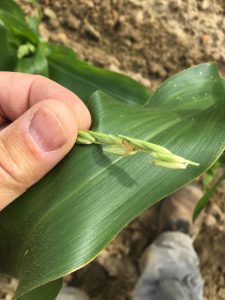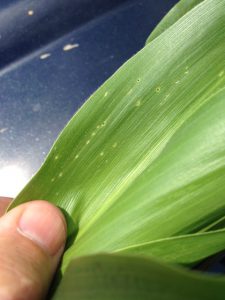Sweet Corn
Fall armyworm (FAW) has begun to appear in coastal areas. We have low level infestations of this pest in whorl stage sweet corn in Monmouth County, and reports of early populations in Cape May, where FAW was a significant problem last season. This pest is capable of significant injury to sweet corn plants, resulting in severe stunting and failure to produce viable ears. Importantly, FAW favors whorl, and even seedling stage sweet corn for egg laying so it is critical that growers check even recently emerged plantings for signs of FAW injury.
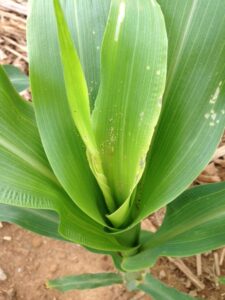
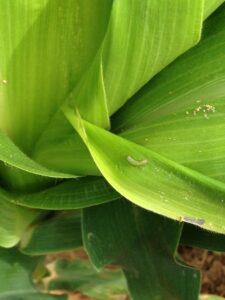 Newly hatched FAW larvae cause holes and scratches on leaves that are similar to European corn borer (ECB) feeding, except that they tend to be more concentrated and always lead down into the whorl (see photos at left). As the larvae grow, the feeding becomes more destructive, with large ragged holes and obvious droppings deposited in the whorl (see photo at right).
Newly hatched FAW larvae cause holes and scratches on leaves that are similar to European corn borer (ECB) feeding, except that they tend to be more concentrated and always lead down into the whorl (see photos at left). As the larvae grow, the feeding becomes more destructive, with large ragged holes and obvious droppings deposited in the whorl (see photo at right). 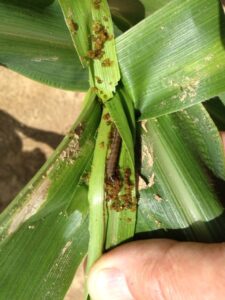
We will provide updates on new FAW appearances and severity as reports come in. FAW are resistant to synthetic pyrethroids. Effective sprays should include IRAC grp. 5 (spinosyns) or IRAC grp. 28 (diamides). The carbamate (IRAC grp. 1A) Lannate is also still effective. Sufficient water should be used in the applications to allow the solution to penetrate the layer of droppings that may have formed above the caterpillar.
European corn borer (ECB) moth activity remains extremely low in areas where blacklight traps are operating in the northern and central counties. Many plantings exhibiting no ECB injury at all. We will report on ECB activity should numbers rebound to potentially damaging levels during the second flight. In recent years, this later flight has not required targeted control in sweet corn.
